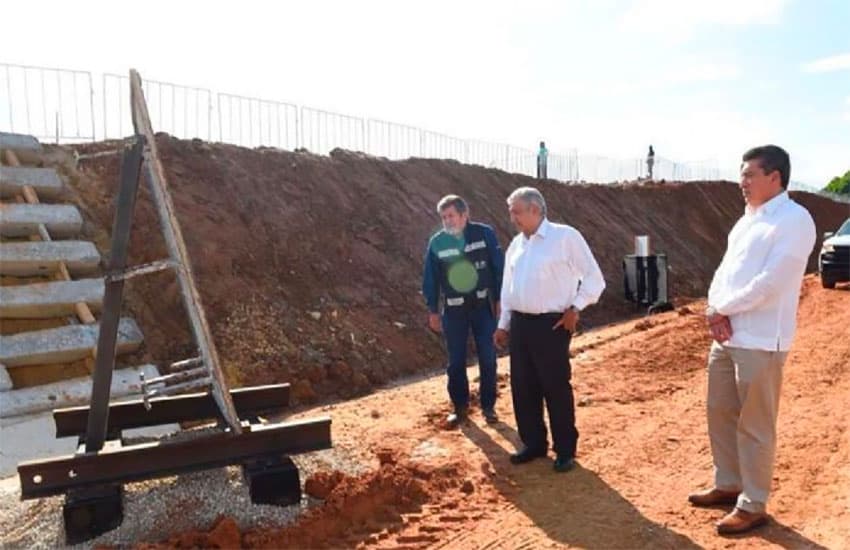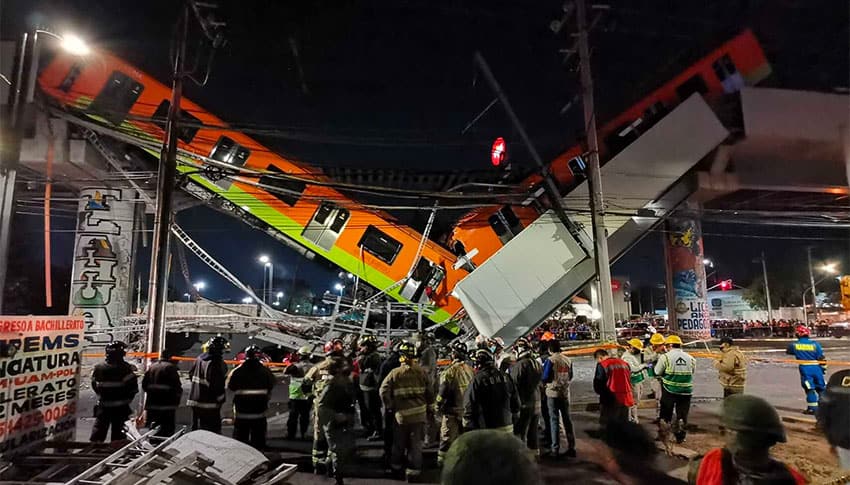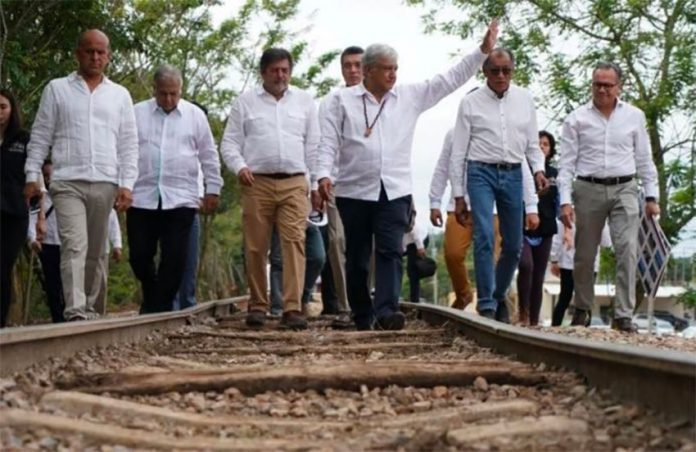Contracts issued by the federal government to build three sections of the Maya Train railroad stipulate construction periods that are too short, the results of a survey of construction companies suggest, raising concerns that the project could be substandard and ultimately dangerous, as Line 12 of the Mexico City Metro – the scene of a deadly disaster last month – proved to be.
The National Tourism Promotion Fund (Fonatur), which is managing the project to build a 1,500-kilometer tourist and freight railway through Chiapas, Tabasco, Campeche, Yucatán and Quintana Roo, has given the companies building sections 1, 2 and 3 of the project 28 months to finish once they have started construction.
The aim is to inaugurate the new railroad before the end of the six-year term of President López Obrador, who has pressured the construction companies to work more quickly.
A market survey conducted by Fonatur, PricewaterhouseCoopers and other consultants in 2019 found that a majority of 21 construction companies believed that a period of at least 36 months was needed to build a 250-kilometer section of railroad – provided everything went smoothly.
However, “companies with more experience in the construction of railroad tracks favor a period between 36 and 48 months,” the survey report said.

All told, about two-thirds of the construction companies consulted said that at least three years were needed to build each section of the railroad, the government’s signature infrastructure project.
Completing a 250-kilometer section in that period of time would require an absence of “delays caused by environmental, social or right of way issues,” the survey report said.
Sections 1, 2 and 3 of the ambitious project – which faces legal challenges from indigenous communities – are all shorter than 250 kilometers, but not significantly so.
Section 1 will run 228 kilometers between Palenque, Chiapas, and Escárcega, Campeche; section 2 will traverse 235 kilometers from Escárcega to Calkinía, Campeche; and section 3 will cover 172 kilometers from Calkiní to Izamal, Yucatán, a stretch that will cross land beneath which there are numerous caverns and cenotes, or natural sinkholes.
López Obrador, who believes that the new railroad will spur economic and social development in Mexico’s long-neglected southeast, appears determined to ensure that the construction companies comply with the 28-month construction period set by Fonatur, asking them on several occasions to speed up the process.
(Construction of the US $8-billion project officially began in early June 2020.)
During a visit to Campeche last December to inspect the progress of section 2 – which is being built by a consortium controlled by business tycoon Carlos Slim – López Obrador offered a “respectful recommendation” to simultaneously work on different parts of the stretch at the same time. “More progress is made that way,” he said.
The president made similar remarks during an inspection of the same section in March, and pledged to visit as frequently as every two weeks if construction fell behind schedule.
“That there is a rush to complete the Maya Train before he leaves the National Palace is more than obvious,” the newspaper El Universal said in a report published Monday, although the work has not kept pace with the president’s predictions.
“In December 2018 [the month the president was sworn in], López Obrador said that construction in Palenque was going to start that month. In February 2019, he promised that the tendering process would begin in March and in June he guaranteed that construction work would begin in 2019. In December of that year, the president guaranteed that there would be construction work in March 2020. Between April 23 and May 15 of 2020, sections 1, 2 and 3 of the Maya Train were awarded and the physical construction work was inaugurated in June, just a month later, providing almost no time to carry out a quality executive project [master plan],” El Universal said.
Construction began very soon after the signing of contracts despite a majority of companies surveyed by Fonatur indicating that they would need six to 12 months to draw up construction plans for a single section of the railroad.
Asked by El Universal why a period of just 28 months was set for each of sections 1, 2 and 3 to be completed and why construction began so soon after the contracts were awarded, Fonatur responded that the companies that submitted successful bids “presented construction work programs” that made a commitment to finish in that period of time “after analyzing in detail the viability of their development.”
“With respect to the beginning of the work, it is the usual norm in these kinds of contracts that the executive project is presented in partial deliveries …” it said.

The apparent rush to complete the train before López Obrador’s term ends in 2024 appears eerily similar to the alleged scramble to open Line 12 of the Mexico City Metro – where 26 people were killed in an accident on May 3 – before former mayor Marcelo Ebrard left office in late 2012.
The preliminary results of an independent investigation indicate that the collapse of an elevated section of Line 12 was caused by a series of faults during construction. The New York Times reached the same conclusion after conducting an investigation based on years of government records, interviews with people who worked on construction of Line 12 and expert analysis of evidence from the site of the crash.
“In a rush to finish, the city demanded that construction companies open the subway well before Mr. Ebrard’s term as mayor ended in 2012. The scramble led to a frenzied construction process that began before a master plan had been finalized and produced a Metro line with defects from the start,” the Times report said.
It also said that the “heralded expansion” of the Mexico City Metro system “could boost his credentials for a possible presidential run.”
However, Ebrard – now foreign minister – denied the claim that the project was rushed for political purposes and suggested that a lack of maintenance during the government led by his successor as mayor, Miguel Ángel Mancera, could have caused the collapse of the overpass.
Two of the companies that worked on construction of Line 12, Slim’s Carso Infrastructure and Construction and ICA, are involved in the construction of the Maya Train project. ICA, a Mexican firm, is building a section between Izamal and Cancún, Quintana Roo.
Fonatur has said that the Maya Train project is being built with the “highest quality and safety standards,” but the Times said it has seen hundreds of messages in which “engineers have discussed construction progressing on [the Maya Train] without plans or details being approved, as well as unfinished designs.”
The director of construction company Coconal, which is not working on the Maya Train project but participated in the Fonatur survey, raised concerns in May about the tight timetable to build the railroad and other large government infrastructure projects, such as the new Mexico City airport and the Dos Bocas oil refinery on the Tabasco coast.
“If the project has risks that you’re going to assume unknowingly … and in addition you know beforehand that it won’t be achieved [on time], you shouldn’t take it on,” Héctor Ovalle said.
Fonatur director Rogelio Jiménez Pons said the Line 12 tragedy was “a timely warning” for the Maya Train project but remained defiantly committed to the 28-month construction period, asserting that the tourism fund has to lay everything on the line to ensure that it is met.
His boss expects no less: the Maya Train has to be ready in 28 months, López Obrador said while inaugurating the project on June 1 last year. No excuses will be accepted for delays, he stressed, asserting that a long period of rain, for example, would not be considered a valid reason for the project falling behind schedule.
While a majority of construction companies surveyed by Fonatur believe that the Maya Train can’t be built in 28 months, the president made his view very clear, declaring unequivocally as he triumphantly waved a starting flag for the project that “of course it can.”
With reports from El Universal
